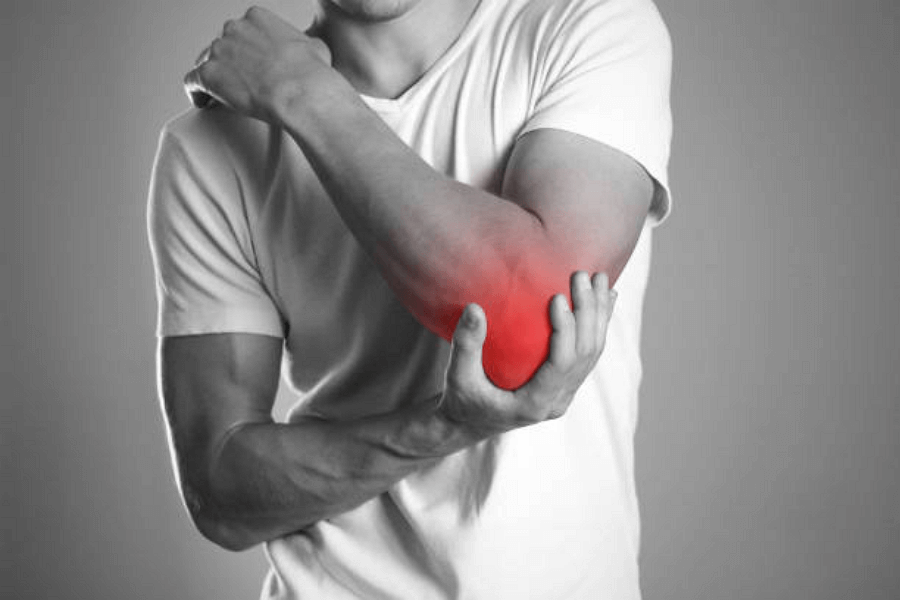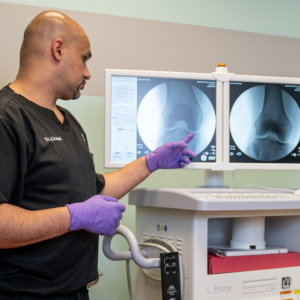Your #1 Charlotte Physiatrist Explains the Causes and Best Treatments for Tennis Elbow

Imagine playing a game of tennis on a sunny day, and you swing your racket for a powerful backhand shot and suddenly, a sharp pain surges through your elbow. This is a typical scenario for someone experiencing tennis elbow, a condition that can occur in individuals who are involved in activities that put strains on their hand and elbow muscles.
If you have been searching for clinics that offer the best tennis elbow treatment in Charlotte, NC and Fort Mill, SC, you have come to the right place. At Advanced Sports and Spine, our physiatrist, Dr. Usman Ahmad, provides regenerative medicines to treat pain in your joints, bones, and muscles.
In this guide, we’ll explain what tennis elbow is, its causes, and how we can manage it and help you live a healthier, better, and pain-free life.
What Is a Tennis Elbow?
Tennis elbow, medically known as lateral epicondylitis, is a condition that causes pain in the outer part of the elbow. It’s often associated with overuse or strain of the muscles and tendons in the forearm that allow for extension or lifting of the wrist.
Despite its name and how common tennis elbow is, it is not exclusive to tennis players. It can affect anyone who performs repetitive activities that strain the forearm muscles.
What Are the Typical Causes of Tennis Elbow?
The typical cause of tennis elbow is the repetitive strain that the muscles and tendons that extend the wrist and fingers are subjected to. This strain results in small, often microscopic tears in these tendons, leading to inflammation and pain.
While playing tennis or other racquet sports can undoubtedly lead to tennis elbow due to the high-stress impact of hitting the ball, other activities can also cause this condition. These include:
- Repetitive computer mouse use
- Painting
- Plumbing
- Cooking
- Gardening
- Playing certain musical instruments
If your routines are subject to any of the above causes, you may be susceptible to developing tennis elbow and this shows how common tennis elbow is. However, if you want to know more about elbow wrist and hand pain relief treatments, visit our office to inquire from our expert physiatrist.
What Are the Most Common Symptoms of Tennis Elbow?
The symptoms of tennis elbow might start off modest but often worsen with time. Most people experience:
- Pain and tenderness on the outside of the elbow
- Stiffness in the elbow
- Weakness in the forearm
- Difficulty extending the forearm.
It’s common for pain to be worse in the morning and get better throughout the day. Pain can also increase with physical activity, such as lifting or gripping objects.
Once you begin to experience these symptoms, don’t wait for them to get so bad that you’ll need to undergo invasive surgical procedures. You should search for a specialist that offers tennis elbow pain relief for diagnoses and possible treatments. Let’s now discuss how tennis elbow is diagnosed at our pain management center.
How Do You Diagnose Tennis Elbows?
This requires a comprehensive evaluation of your symptoms, medical history, and some physical examination. As the foremost physiatrist who provides elbow pain treatments in Charlotte and Fort Mill, here’s how tennis elbow is diagnosed according to Dr. Ahmad:
- Physical Examination: This is the first step in diagnosing tennis elbow. We’ll examine your elbow for signs of pain or tenderness. You may be asked to flex your arm, wrist, and fingers to see where it hurts.
- Medical History: You’ll be asked about your activities, which could be causing the problem, and whether there have been any injuries to the area.
- Imaging Tests: If the diagnosis is unclear, imaging tests can provide a more detailed look at your elbow. An MRI scan can produce detailed images of bones and soft tissues like tendons.
- X-rays: While X-rays don’t visualize soft tissues like tendons, they can rule out other conditions that cause elbow pain, such as arthritis or fractures.
- Electromyography (EMG): This test measures the electrical activity in your muscles to identify nerve compression. As a result, you can eliminate the possibility of nerve entrapment or a cervical issue as the source of your elbow pain.
Remember, an accurate diagnosis is the key to effective treatment. If you’re experiencing symptoms of tennis elbow, don’t hesitate to seek professional help.
Regenerative Medicine for Tennis Elbow Treatment
Regenerative medicine is a cutting-edge field that harnesses the body’s innate ability to heal itself. It’s an exciting tennis elbow treatment that offers a potential alternative to more invasive procedures like surgery.
1. PRP Therapy
Platelet-rich plasma (PRP) therapy is a form of regenerative medicine that uses your blood components to promote healing. With PRP therapy, a small portion of your blood and cells are drawn. The platelets are separated and injected into the injured area to promote tissue repair.
PRP therapy helps your body harness its healing powers and also stimulates the production of collagen, which is an important protein necessary for strengthening connective tissues.
2. Bracing
Bracing or immobilizing the elbow can help rest the muscles and tendons, reducing strain and promoting healing. Bracing can be used in conjunction with regenerative medicine to maximize results.
The truth is that regenerative medicine treatments can facilitate the healing of injuries to the bone, cartilage, muscle, tendon, and ligaments. This is especially true for patients with tennis elbow. Often, these treatments can prolong or even eliminate the need for orthopedic surgery.
If you’re suffering from tennis elbow and looking for the best tennis elbow treatment in Charlotte, our regenerative medicine treatment should be your go-to option. It is a safe, efficient, and natural alternative to surgery.
Effective Non-surgical Treatment for Tennis Elbow in Charlotte and Fort Mill

If you’re experiencing the discomfort of tennis elbow, know that you’re not alone and that help is available. As a leading physiatrist in the region, Dr. Ahmad specializes in non-surgical treatment options that can provide significant relief from elbow, wrist, and hand pain.
Remember, early intervention is vital to a speedy recovery. Don’t let tennis elbow in Charlotte and Fort Mill keep you off the court or interfere with your daily activities. Reach out to us today for effective tennis elbow treatment near Charlotte and Fort Mill. We’re here to help you get back to doing what you love, pain-free.
Schedule your appointment with us for exceptional tennis elbow pain management today!
Disclaimer: The benefits of regenerative medicine have not been reviewed or approved by the FDA.
